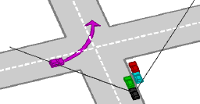Probabilistic Models for 3D Urban Scene Understanding from Movable Platforms

Visual 3D scene understanding is an important component in autonomous driving and robot navigation. Intelligent vehicles for example often base their decisions on observations obtained from video cameras as they are cheap and easy to employ. Inner-city intersections represent an interesting but also very challenging scenario in this context: The road layout may be very complex and observations are often noisy or even missing due to heavy occlusions. While Highway navigation and autonomous driving on simple and annotated intersections have already been demonstrated successfully, understanding and navigating general inner-city crossings with little prior knowledge remains an unsolved problem. This thesis is a contribution to understanding multi-object traffic scenes from video sequences. All data is provided by a camera system which is mounted on top of the autonomous driving platform AnnieWAY. The proposed probabilistic generative model reasons jointly about the 3D scene layout as well as the 3D location and orientation of objects in the scene. In particular, the scene topology, geometry as well as traffic activities are inferred from short video sequences. The model takes advantage of monocular information in the form of vehicle tracklets, vanishing lines and semantic labels. Additionally, the benefit of stereo features such as 3D scene flow and occupancy grids is investigated. Motivated by the impressive driving capabilities of humans, no further information such as GPS, lidar, radar or map knowledge is required. Experiments conducted on 113 representative intersection sequences show that the developed approach successfully infers the correct layout in a variety of difficult scenarios. To evaluate the importance of each feature cue, experiments with different feature combinations are conducted. Additionally, the proposed method is shown to improve object detection and object orientation estimation performance.
| Author(s): | Andreas Geiger |
| Year: | 2013 |
| Month: | April |
| Bibtex Type: | Ph.D. Thesis (phdthesis) |
| Electronic Archiving: | grant_archive |
| Institution: | Karlsruhe Institute of Technology |
| School: | Karlsruhe Institute of Technology |
| Links: | |
BibTex
@phdthesis{Geiger2013,
title = {Probabilistic Models for 3D Urban Scene Understanding from Movable Platforms},
abstract = {Visual 3D scene understanding is an important component in autonomous
driving and robot navigation. Intelligent vehicles for example often
base their decisions on observations obtained from video cameras
as they are cheap and easy to employ. Inner-city intersections represent
an interesting but also very challenging scenario in this context:
The road layout may be very complex and observations are often noisy
or even missing due to heavy occlusions. While Highway navigation
and autonomous driving on simple and annotated intersections have
already been demonstrated successfully, understanding and navigating
general inner-city crossings with little prior knowledge remains
an unsolved problem. This thesis is a contribution to understanding
multi-object traffic scenes from video sequences. All data is provided
by a camera system which is mounted on top of the autonomous driving
platform AnnieWAY. The proposed probabilistic generative model reasons
jointly about the 3D scene layout as well as the 3D location and
orientation of objects in the scene. In particular, the scene topology,
geometry as well as traffic activities are inferred from short video
sequences. The model takes advantage of monocular information in
the form of vehicle tracklets, vanishing lines and semantic labels.
Additionally, the benefit of stereo features such as 3D scene flow
and occupancy grids is investigated. Motivated by the impressive
driving capabilities of humans, no further information such as GPS,
lidar, radar or map knowledge is required. Experiments conducted
on 113 representative intersection sequences show that the developed
approach successfully infers the correct layout in a variety of difficult
scenarios. To evaluate the importance of each feature cue, experiments
with different feature combinations are conducted. Additionally,
the proposed method is shown to improve object detection and object
orientation estimation performance.},
institution = {Karlsruhe Institute of Technology},
school = {Karlsruhe Institute of Technology},
month = apr,
year = {2013},
slug = {geiger2013},
author = {Geiger, Andreas},
month_numeric = {4}
}
